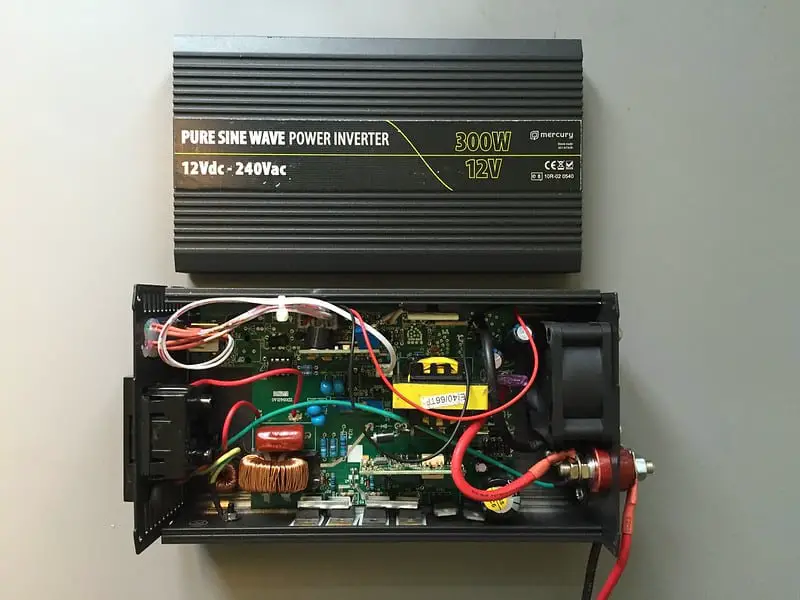Before we discuss how an inverter works in an RV, first let’s figure out whether or not your RV has an inverter. This will be an easy one: All you have to do is observe how the 120-volt wall outlets in your rig operate. If they only work when you are connected to shore power but not at any other time, unless you have a generator running, your RV does not have an inverter.
What Is An RV Inverter?
An inverter is sort of your secret weapon that powers up the RV so that you can use various appliances. Technically speaking, an inverter is an electronic module and even if your rig does not have one, you can easily add one to it.
There are advantages to having one such as being able to park and camp away from a power source and still be able to use the microwave or TV. Depending on the type of RV you have, inverters may be pre-installed in some models.

How Does An Inverter Work In An RV?
Inverters are powered by the 12-volt battery of the rig and inverts (hence the name) the 12VDC from the battery to 120VAC power for wall outlets inside the RV. Know that you can use the inverter to power up anything that plugs into an outlet inside your RV but it will only have as much power as the battery that it is running off of.
In other words, an air conditioner, blow dryer and microwave will likely max the system out if all three were operating simultaneously and you had little battery power.
When Do You Need An Inverter?
This will be one of your biggest deciding factors when you are shopping for an RV inverter. What you need to figure out is what exactly will you need the power for. If you are even just a casual RVer, you are going to want to be able to use any of the wall outlets so you will want to power everything.
That’s pretty normal. Or you could just choose to select a few outlets and have them dedicated for inverter use only. Again, not an uncommon approach. You could also go in the middle here and opt to use multiple inverters. It isn’t such a bad idea, either.
Inverter Vs Converter:
What’s The Difference/How Do They Work?
We have already outlined how an RV inverter operates, and you have very likely heard of power converters. This is a very different kind of technology when compared to inverters.
The converter is sort of a power controlling device. What it does is it takes the 120-volts AC you are getting fed into your RV when you connect to a power source and converts it down to 12-volts DC so that you can plug in any of your appliances and use them as you desire.
But the converter does another important job: By converting connected power, it keeps your battery from draining.
Finding The Best Inverter For Your RV:
What Type Do You Need?
When you start looking at RV inverters you are going to discover that there are two different types. There are standalone units and integrated models. The names should be self-explanatory and each works best in specific settings.
Standalone Inverter
The standalone is a good solution if you are adding it to a contemporary multi-stage charging system that can handle the size of the battery bank.
Integrated Inverter
The integrated style is probably your best choice if you have an older converter/charger and are looking to upgrade from there.
Finding The Best Inverter For Your RV: How Many Watts Does Your Inverter Need?
The sizing of RV inverters is based on wattage and the more power, the more the inverter will cost. For example, let’s look at an inverter that is rated at 2,000-watts. This unit can supply up to 2,000W at a time, provided your battery bank can support it.
Remember, your batteries will dictate how large an inverter you can safely operate within your RV power system. There is no doubt that 2,000-watts sounds like a lot of power so let’s break that down for you.
A standard wall outlet in your RV is rated for up to 15-amps at 120-volts. That totals a maximum of 1,800-watts. For routine needs inside your rig, you can get along well with an inverter that falls between the parameters of 1,000 and 2,000-watts.
If you only use the outlets in your RV to charge your smartphone and operate your laptop computer, you may be able to use a much smaller inverter such as one rated for 500-watts, provided the RV battery can handle that.
Finding The Best Inverter For Your RV:
Pure Sine Vs Modified Inverters
As if there weren’t already enough different categories that RV inverters fall under, here are two more. When you are shopping for yours, you are going to encounter the terms pure sine and modified sine. You can probably guess from the terms themselves that one is very different from the other, but what exactly is the difference? Here is a simple explanation for you to help you figure out why a pure sine RV inverter is not the same as a modified sine model.
Pure Sine
A pure sine RV inverter is your best option in that it exactly imitates the standard power that would be coming from the power source (electric utility via shore power or a power generator).
You can check out the highest rated Pure Sine inverters now on Amazon.
Modified Sine
A modified sine RV inverter approximates the standard power and as a result, often falls short. In other words, some of your appliances are not going to work properly, if at all, with a modified sine inverter feeding them a bit less juice than they require.
There is an interesting aside to this. There was a time when pure sine inverters were the only game in town and as a result, they were costly. The modified sine variety was created several years ago as a budget option at a fraction of the price.
They also gave you a fraction of the power you needed to run an alarm clock, coffee maker, and most anything else you depended on while on your RV holiday. As it turned out, pure sine models came down in price.
You can check out the highest rated Modified Sine inverters now on Amazon.
Are RV Inverters Reliable?
You have to look at the RV inverter in your rig as you would most any other kind of electronic device. They are made with solid-state electronics which means your inverter should perform with little or no issues for several years.
But, like all electronics, high heat and moisture will wear them down faster. Many designs have a built-in cooling fan and if you mount the inverter in a dusty location, be prepared to clean the fan every so often to keep it running well.
If your RV does not use sealed batteries, it is wise to mount the inverter in a location away from the battery bank. Acid fumes from flooded cell batteries can cause damage to the inverter.
What Is An ATS Used For?
The ATS is the Auto(matic) Transfer Switch. What this does is it senses whether or not power is present at the source and will automatically change to an alternate source, when needed. As an example, your RV shore power source is connected to one side of the ATS and the inverter is connected to the opposite side. When shore power is detected, the ATS selects that as the primary power source for your RV. If there is no shore power, the ATS flips to the inverter.
Installing The RV Inverter, Is It Easy To Do?
Well, you don’t need a degree in electricity to hook up the inverter in your RV but you do need to pay attention to wiring and stuff like that. Essentially, installing the inverter is rather easy because all you are doing is wiring it directly to the RV battery bank with large battery cables. Where installation gets a bit on the tricky side is when you are routing the inverter 120-volt output power to where you need it to go within your RV. This means you will be getting up close and personal with the breaker panel in your rig. Take your time and you should get through it.
In Conclusion
Inverters are nifty little devices that will keep the wall outlets in your RV warm and filled with power when you want to catch the game or fix up a pitcher full of margaritas. But not all inverters are made the same nor is there such a thing as a one-size-fits-all power solution for RVs. Hopefully, we have taught you a few things about these devices and shared enough knowledge about them that you can confidently go out there and shop for the best solution for your RV.



